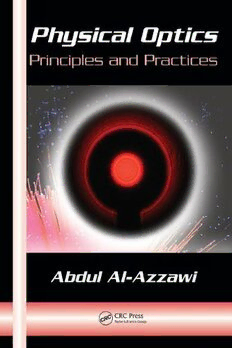Table Of Contentq2006byTaylor&FrancisGroup,LLC
q2006byTaylor&FrancisGroup,LLC
q2006byTaylor&FrancisGroup,LLC
Preface
Weliveinaworldbathedinlight.Lightisoneofthemostfamiliarandessentialthingsinourlives.
Formanythousandsofyears,theSunwasouronlysourceoflight.Eventually,theabilitytocreate
fire, and its by-product, light, led to a profound change in the way humans managed their time.
Light is used to treat those with seasonal disorders. Lasers are now used in medical applications,
suchasre-shapingourcorneas,cauterizingbloodvesselsandremovingtattoos.Lasersarealsoused
in industrial applications, such as cutting metal, welding and sensing. New imaging technology
permitsthecreationofflat-paneldisplays,nightvisiondevicesandautonomousproductinspection
systems.Withsomanyapplicationsoflight,theneedforPhotonicstechnologyandinnovationwill
most certainlygrow in the future, as new applicationsemerge tolight.
A unique approach is taken in this book to present physical optics and their applications. This
book covers the basic theoretical principles and industrialapplications of physical optics suitable
for students, professionals and professors. Each chapter is presented in two parts: theoretical and
practical.Thetheoreticalparthasadequatematerialtocoverthewholeaspectofthesubject.Inthe
experimental part, students will apply the learned theoretical concepts in simple and advanced
experimentalworks.Inthisway,studentswilllearnandgainpracticalhands-onexperienceinthe
Photonics subjects. This will assist the students to apply theoretical knowledge to real-world
applications.Thestep-by-stepapproachandtechnicalillustrationsinthisbookwillguidestudents
througheachexperiment.Theexperimentalworkhasmorethanonecaseinmostofthechapters,
and sometimeshave sub-cases.
Thisbookiswritteninsimplelanguage,andgivesadequateinformationandinstructiontoenable
students to achieve maximum comprehension. An effort has been made to use the international
systemofunits(SI)throughoutthebook.Theorganizationofthechaptersisdesignedtoprovidea
solid foundation for today’s physical optics students, and to upgrade their knowledge. Universal
tools, devices and equipment, which are used throughout the experiments, are available in any
Photonics,Physicsandmateriallabs.Thisbookaboundsintheoreticalandpracticalaids,andisan
effectiveteachingtool,helpfultobothprofessorsandstudents.Simpleandadvancedsubjectsare
presentedby an expert author, and somenew subjects appear for the first time inthis book.
Care has been taken to label parts clearly, and to use colours in diagrams wherever it will aid
understanding. Some figures are drawn in three dimensions, where applicable, for easy under-
standing of the concepts. Colour pictures are used to clearly show parts in a device, system and
experimental setup.
Thebookisstructured into seven chapters. The book includesthe followingchapters:
† Chapter1throughChapter5coverswaves, diffraction andinterference, the diffraction
grating, interferometers andspectrometers.
† Chapter6 covers laser technology.
† Chapter7 covers laboratory safety.
The book includes 222 figures, 19 tables and 22 experimental cases. The book was developed
withgenerousinputfrommembersofthephotonicsindustry,researchscientists,andmembersfrom
academia.
AbdulAl-Azzawi
AlgonquinCollege
Canada
q2006byTaylor&FrancisGroup,LLC
Acknowledgments
This book would not have been possible without the enthusiasm and teamwork of my colleagues
andfamilysupport.Inparticular,theauthorwouldliketothankMietekSlocinskiforhissupport,
time and energy in working long hours to set up the labs, taking pictures, and fruitful discussion
during the yearstocomplete the book.
The author would like to thank Steve Finnegan, Kathy Deugo and Nicole McGahey for their
supportand solving the difficulties.
TheauthorwouldliketothankhisdaughterAbeerandsonAbaidafortheirhelpinreviewingthe
chaptersand making drawingsand figures.
TheauthoralsoextendshisthankstoEng.MonicaHavelockforhercontributioninworkinglong
hours in reviewingand editingthe materials, and support.
TheauthorwishestoexpresshisgratitudetohiscolleaguesProf.DevonGalwayandProf.Rao
Kolliparafor their comments andfeedback in reviewingsomematerials in thisbook.
TheauthorwishestothankGergelyHorvathforhardworkinreviewingandproofreadingmost
chaptersinthisbook.TheauthorlikestothankMadeleineCamm,AndrewLynchandNicolasLea
for reviewingafew chapters inthis book.
TheauthorwouldliketoextendhisthankstoDrGovindanunnyThekkadathforreviewingand
proposingsome materialsinthis book.
TheauthorwouldliketoextendhisthankstoDrRobertWeeksforparticipatingwithAbdulin
writing andreviewingthe lasers chapter.
q2006byTaylor&FrancisGroup,LLC
Author
AbdulAl-Azzawi,PhD,graduatedfromtheUniversityofStrathclydeinGlasgow,Scotland,UK.
Hehasworkedinthephotonicsmanufacturingindustry,research(NRC/Canmet),andteachingat
AlgonquinCollege,Ontario,Canada.WhileemployedatNRC,heparticipatedinstudyingenergy
saving in a residential building and developing the green building assessment programme. As a
photonicsengineer,hedesignednewproductionlines,modifiedproducts,developedmanufacturing
process, and designed new jigs.
At Algonquin College, he has taught mechanical and photonics courses in the mechanical and
photonics engineering programmes. He was a member of the founding team of the Photonics
EngineeringProgrammes.Hehaspublishedthreebooksandmanypapers,andhehasparticipated
inmanyworkshopsandconferencesaroundtheworld.Heistheauthorofthebook,FibreOptics—
Principlesand Practices.
He is the coordinator of the photonics engineering programme at Algonquin College, Ottawa,
Ontario,Canada.Hisspecialareaofinterestisopticandopticalfibredevices,fibreopticlighting,
andfibreopticsensors.HeisamemberoftheprofessionalphotonicssocietiesinCanada.Heisthe
recipient ofthe NISODExcellence award from the University ofTexas at Austin in2005.
q2006byTaylor&FrancisGroup,LLC

